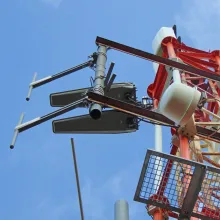We stand on the brink of a technological revolution that will fundamentally alter the way we live and work. The possibilities of billions of people across the globe connected by mobile devices, with unprecedented processing power and access to knowledge, are unlimited. Technological innovation remains the single most important driver of economic prosperity; it alone has the power to raise global living standards through increased efficiencies. Powertec are proud to contribute to the Fourth Industrial Revolution in our own small way, providing free and unhindered access to educational wireless technology resources.
The complex nature of wireless technologies can make procuring associated hardware an unclear process. As part of our commitment to standardisation and informational symmetry, Powertec is working to build a comprehensive educational resource covering as many wireless technologies as we can.
Technology Resources
Bluetooth wireless technology enables electronic devices to connect and communicate wirelessly. It is a standard for the short-range wireless interconnection of cellular phones, computers, and other electronic devices. Invented by Ericsson in 1994, it is a method of exchanging data over short distances using radio waves from fixed and mobile devices, creating personal area networks. Bluetooth technology operates by using the licence-free 2.4 GHz ISM band to transmit data, eliminating the need ...
Cellular mobile technology refers to a form of wireless communication technology that is characterised by its use of a distributed network of base stations, commonly referred to as cell towers. This network is divided into multiple geographic areas, each served by at least one fixed-location transceiver, known as a cell. The defining feature of cellular technology is its ability to manage high volumes of simultaneous calls and data transmissions by employing a method of frequency reuse across ...
Global Navigation Satellite System (GNSS) technology refers to a network of satellites providing signals from space that transmit positioning and timing data to GNSS receivers. These receivers then use this data to determine location. The most widely known GNSS is the United States' Global Positioning System (GPS), but other countries and regions have developed their own systems, such as Russia's GLONASS, the European Union's Galileo, and China's BeiDou.
GNSS technology functions by transmitting ...
Wireless telemetry or Machine-to-Machine technology was adopted early by businesses that could see the value in data and it quickly became commonplace to deploy these systems in applications such as metering. From simple beginnings M2M has sophisticated to a point where it is almost synonymous with the Internet of Things, an association which is likely to strengthen further. IoT is becoming an increasingly prominent technology that has the potential, and is already making steps towards ...
Microwave technologies use electromagnetic waves in the microwave band to achieve wireless communication. While the microwave band theoretically includes all frequencies above 300 MHz, in common practice the term is used to describe communication conducted above 3 GHz. These frequencies are referred to as centimetre-wave and millimetre-wave (mmWave) bands.
Ultra High Frequency (UHF) technology officially spans a significant portion of the electromagnetic spectrum, ranging from 300 MHz to 3 GHz. However the term UHF is often used to refer primarily to the lower portion of this range, particularly focusing on frequencies between 300 MHz and 600 MHz. This subset is widely used for various radio communication and broadcasting applications due to its medium-long range propagation characteristics.
The UHF band is known for its ability to provide higher ...
WiFi is a widely recognised wireless networking technology, allows electronic devices to connect to a local area network primarily through the 2.4 GHz and 5 GHz radio bands. It is based on the IEEE 802.11 family of standards and is used for providing internet access and network connectivity for a variety of devices including computers, smartphones, tablets, smart devices, and more.
The fundamental principle of WiFi involves the use of one or more wireless access points, which acts as the central ...






